The Best Fluffy Pancakes recipe you will fall in love with. Full of tips and tricks to help you make the best pancakes.
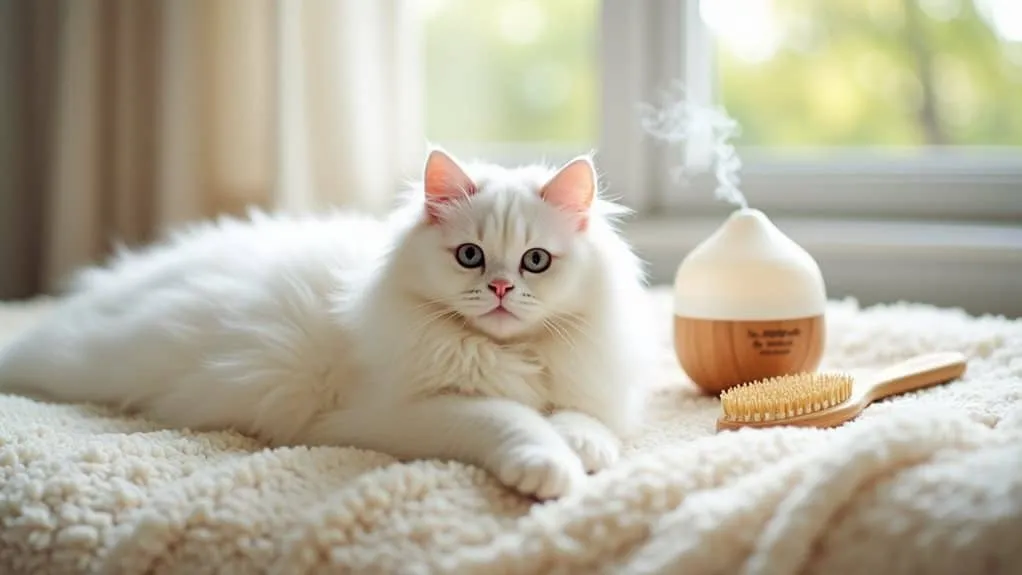
If you've noticed your feline friend scratching more than usual or sporting flaky patches during the winter months, you're not alone. Just like humans, cats can suffer from dry, irritated skin when temperatures drop and heaters kick into high gear. While your kitty's natural coat provides excellent protection, the harsh winter environment can still take its toll on their sensitive skin. Let's explore how you can keep your furry companion comfortable and itch-free throughout the chilly season.
Understanding Winter's Impact on Feline Skin Health
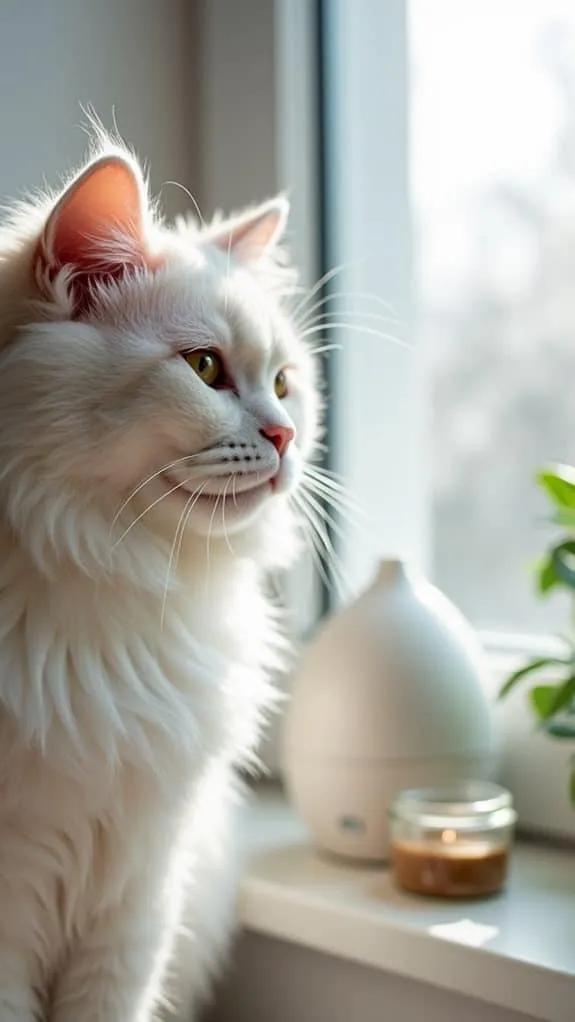
While your feline friend may seem well-protected by their fluffy coat, winter's harsh conditions can take a serious toll on their sensitive skin.
Just like us, your cat's skin struggles to retain moisture during cold weather, and those cozy indoor heating systems aren't doing them any favors. Keep in mind that central heating systems dramatically affect indoor air quality. Winter hydration becomes essential as your kitty faces a double challenge: cold, wet conditions outside and dry indoor air. Regular grooming sessions can help maintain healthy skin and coat condition during the winter months, as grooming promotes better circulation and overall skin health. You'll want to watch for signs of feline allergies, which can worsen during winter months when your pet spends more time indoors.
The combination of indoor allergens, temperature fluctuations, and reduced natural oil production can leave your cat's skin feeling itchy and uncomfortable. Understanding these seasonal challenges helps you provide better care for your furry family member's delicate skin.
Creating the Perfect Indoor Environment
You'll want to create a cozy haven for your sensitive kitty by maintaining indoor humidity between 30-50% and keeping temperatures steady at 70°F. Setting up plush beds near (but not too close to) heat sources gives your feline friend the perfect spots for winter lounging, while adding soft blankets creates irresistible snuggle zones. Just like humans, cats need to retain natural moisture during the cold winter months. Consider investing in enrichment toys to keep your cat active and engaged while staying warm indoors. Engaging in playtime boosts their emotional support and companionship, which is critical for their well-being.
Remember to place these cozy rest areas away from drafty windows and doors, ensuring your cat's sensitive skin stays protected from harsh winter conditions.
Managing Humidity Levels
During the winter months, managing indoor humidity levels becomes essential for your sensitive feline's comfort and health.
With indoor climate playing an important role in your cat's well-being, you'll want to maintain humidity levels between 30% and 50% through proper humidity control measures. An ultrasonic cool mist humidifier provides the safest and most effective option for cats. Always use distilled water to prevent harmful bacteria and mold growth. Adequate hydration helps support various bodily functions and can improve overall skin health.
Here are three simple ways to create the perfect moisture balance for your kitty:
- Install a humidifier in rooms where your cat spends the most time
- Monitor humidity levels daily using a hygrometer
- Guarantee proper ventilation while running your heating system
You can also help your cat's skin retain moisture through regular grooming sessions.
By maintaining ideal humidity levels, you're protecting your furry friend from uncomfortable dry skin, respiratory issues, and other winter-related discomforts.
Optimal Temperature Settings
Now that you've created the perfect moisture balance for your cat, let's focus on keeping your furry friend at just the right temperature.
Your sensitive kitty will thrive in temperatures between 77-86°F, which might feel a bit warm to you but is perfect for their needs. During those chilly winter months, make sure your indoor heating maintains this cozy range. Be mindful that indoor heating systems can create extremely dry air that may affect your cat's comfort. Keeping your home at the right temperature, along with providing safe outdoor enclosures, enhances your cat's overall well-being. Keep in mind that your cat's body temperature ranges from 99 to 102.5°F, so they naturally prefer warmer environments than humans do.
To help your cat manage temperature fluctuations, create warm spots throughout your home where they can snuggle up when they're feeling chilly.
Place soft beds near sunny windows, and don't forget to draw the curtains when it gets too hot. If you notice your cat seeking cooler spots or becoming less active, it's time to adjust your thermostat.
Cozy Rest Areas
Creating a cozy indoor sanctuary helps sensitive cats thrive during the chilly winter months.
You'll want to focus on setting up quiet, secure cozy corners where your kitty can retreat from the household hustle. Consider transforming elevated spaces like window perches or cat trees into warm hideaways with soft blankets and cushions. Maintaining stable room temperatures is crucial to prevent skin issues in sensitive cats. Our experience providing 8-foot ceiling suites at Cozy Cats Hotel shows how cats truly flourish with ample vertical space, as grooming reduces shedding and keeps their environment clean and comfortable.
Here's what your cat needs for ultimate winter comfort:
- A dedicated hideaway spot under furniture or in closet corners, complete with plush bedding
- Multiple elevated spaces with cat-friendly shelves or perches near windows
- Soft lighting and calming elements, like pheromone diffusers, to create a peaceful atmosphere
Remember to respect your cat's privacy when they're resting in these spaces.
You'll know you've created the perfect winter retreat when your furry friend starts claiming these cozy spots as their own.
Essential Dietary Changes for Healthy Skin
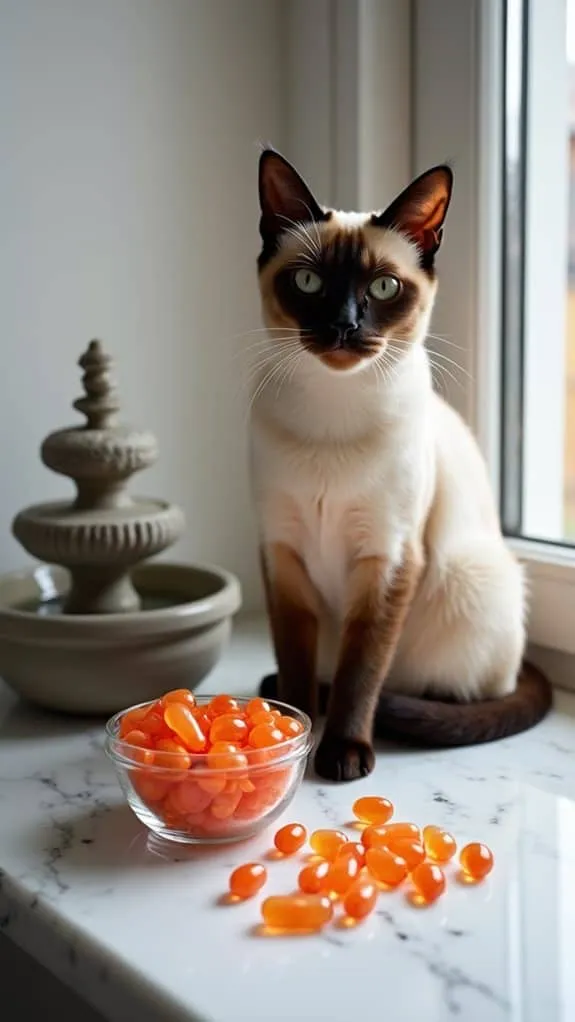
Making smart dietary changes is essential for maintaining your sensitive cat's skin health during winter.
You'll want to focus on nutrient sources rich in omega-3 and omega-6 fatty acids, which help prevent dry, flaky skin and maintain a lustrous coat. Consider adding high-quality dietary supplements if your vet recommends them, especially fish oil for those essential EPA and DHA benefits.
Choose premium protein sources like salmon or chicken, which provide the building blocks for healthy skin cell renewal.
If your kitty's currently eating dry food exclusively, try incorporating some moisture-rich wet food into their diet.
A balanced combination of nutrients won't just keep their skin healthy – it'll help prevent inflammation and support their overall well-being during the harsh winter months. Additionally, ensuring access to clean, fresh water is crucial for preventing dryness and maintaining skin barrier function.
Smart Grooming Practices During Cold Months
Your cat's winter grooming routine doesn't have to be complicated, but you'll want to use natural oil-enriched brushes to keep their coat healthy while preventing painful tangles. You can establish a gentle bathing schedule that won't strip their skin's natural oils, spacing baths 4-6 weeks apart during the cold season. When selecting moisturizing products, look for cat-specific formulas with ingredients like oatmeal and aloe vera, which will soothe your kitty's sensitive winter skin without causing irritation. Regular grooming reduces shedding and helps maintain coat health, which is especially important during the winter months.
Brush With Natural Oils
While winter months can be tough on your cat's coat and skin, proper brushing techniques combined with natural oils can keep your feline friend comfortable and healthy.
When you're grooming your kitty, consider using diluted natural oils like coconut or olive oil to help with matted fur and promote skin health. Just remember to always check with your vet first!
Here's what you'll need for a successful grooming session:
- A wide-toothed comb for gentle detangling
- A soft brush with gentle bristles for sensitive areas
- Your vet-approved natural oil mixture in a spray bottle
Start by applying a small amount of diluted oil to trouble spots, then gently work through the fur with your comb. Maintaining a balanced diet will also support your cat's coat health during winter months.
You'll love seeing how the natural oil benefits combine with proper brushing techniques to give your cat a shiny, healthy coat.
Gentle Bath Schedule Tips
Since winter months pose unique challenges for feline bathing, establishing a gentle and mindful bath schedule becomes essential for your cat's well-being.
You'll want to limit bath frequency to only when it's truly necessary, like after your kitty's gotten into something messy or been caught in winter rain.
Create warm conditions for bath time by keeping the room toasty and draft-free.
If you're caring for an indoor cat, you might only need to bathe them a few times during the winter season.
For outdoor adventurers or long-haired beauties, you may need to adjust the schedule accordingly.
Remember, there's no one-size-fits-all approach – your cat's age, health, and lifestyle will guide your decisions.
When in doubt, spot cleaning with a warm washcloth can be a perfect alternative to full baths. Additionally, ensure that regular grooming, especially for long-haired cats, helps reducing shedding and hairballs during the colder months, as this can improve overall skin and coat health.
Moisturizing Product Selection Guide
Selecting the right moisturizing products during winter months can make a significant difference in your cat's skin and coat health. When choosing moisturizing ingredients, look for products containing Omega-3 and Omega-6 fatty acids, which are essential for maintaining your kitty's natural skin barrier.
Always prioritize product safety by selecting vet-approved options specifically designed for feline use.
Here's what to take into account when picking the perfect moisturizer for your furry friend:
- Check the label for natural, pet-safe ingredients that won't irritate your cat's sensitive skin.
- Choose products with a gentle, non-greasy formula that won't leave residue on their fur.
- Opt for fragrance-free options to avoid potential allergic reactions.
Remember to introduce new products gradually and watch for any signs of sensitivity or discomfort in your cat. Additionally, consider using gentle hypoallergenic shampoos that can complement your moisturizing routine for overall skin health.
The Role of Humidity in Cat Comfort
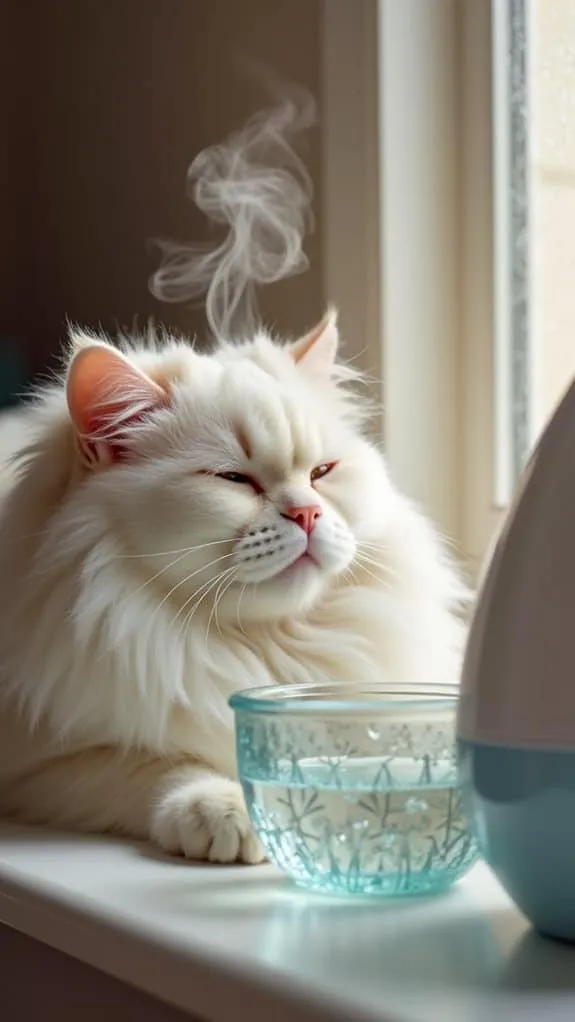
Just as your feline friend needs the right temperature to stay cozy, humidity plays an essential role in their overall comfort and well-being.
If you've noticed your cat scratching more than usual or their fur looking a bit lackluster, humidity fluctuations might be the culprit. Your kitty thrives in environments with 40-60% humidity, and maintaining proper humidity control can make a world of difference in their health.
You can help your sensitive friend by investing in a humidifier for those dry winter months when indoor heating strips moisture from the air.
If you're dealing with high humidity, a dehumidifier will prevent those pesky fungal issues that can trouble your cat.
Don't forget to keep a hygrometer handy – it's your best friend in monitoring these levels and keeping your furry companion comfortable.
Natural Remedies for Dry Skin Relief
When your kitty's skin needs extra TLC during winter, you'll find several natural, oil-based treatments right in your kitchen cabinet, with coconut oil being a popular choice for its gentle moisturizing properties.
You can safely massage a small amount of coconut oil into your cat's dry patches, focusing on areas where they can't easily lick it off, like behind the ears or along the back.
For cats who don't tolerate coconut oil well, plant-based alternatives like calendula-infused oil or chamomile sprays can offer similar soothing benefits without causing digestive upset if licked.
Oil-Based Home Treatments
Natural oils provide a gentle and effective way to soothe your cat's dry winter skin without harsh chemicals. When it comes to oil benefits, coconut oil stands out as a fantastic moisturizer, while CBD oil can help calm irritated skin.
You'll find that proper oil application makes all the difference in your kitty's comfort level.
Here's how you can apply these healing oils to help your furry friend:
- Gently massage coconut oil into dry patches during your regular grooming session.
- Add a few drops of pet-safe CBD oil to their bath water for a soothing soak.
- Mix jojoba oil with their regular shampoo for extra moisturizing power.
Remember to start with small amounts and watch how your cat responds to the treatment. Your gentle care will help keep their skin healthy and comfortable throughout the winter months.
Safe Plant-Based Moisturizers
Plant-based moisturizers offer your sensitive kitty a gentle path to relief from winter's harsh effects on their skin.
When you're looking for natural ingredient sources, aloe vera stands out as a superstar for its soothing and anti-inflammatory properties. You'll find this healing plant in many high-quality cat shampoos, working alongside other plant-based benefits like hydrolyzed oat protein and safflower seed oil.
For the most tender loving care, try products containing colloidal oatmeal, which provides amazing moisturizing effects while calming your kitty's itchy skin.
Coconut-based cleansers are another fantastic option – they're not only gentle on your cat's sensitive skin but also kind to the environment.
Coconut Oil Application Tips
Treating your sensitive kitty's winter-worn skin with coconut oil provides a gentle, effective remedy that's both safe and natural. When applying coconut oil topically, you'll want to start with clean, dry skin and use just a small amount to test your cat's tolerance.
For best results, gently massage the oil into affected areas once daily, paying special attention to dry patches or irritated spots.
Here's how to apply coconut oil effectively:
- Clean the affected area with sterile saline solution, then pat dry completely.
- Warm a pea-sized amount of coconut oil between your fingers until it becomes liquid.
- Apply with gentle circular motions, letting your cat's body heat help absorb the oil.
Remember to monitor your kitty for any adverse reactions and consult your vet if skin issues persist.
When to Seek Professional Help
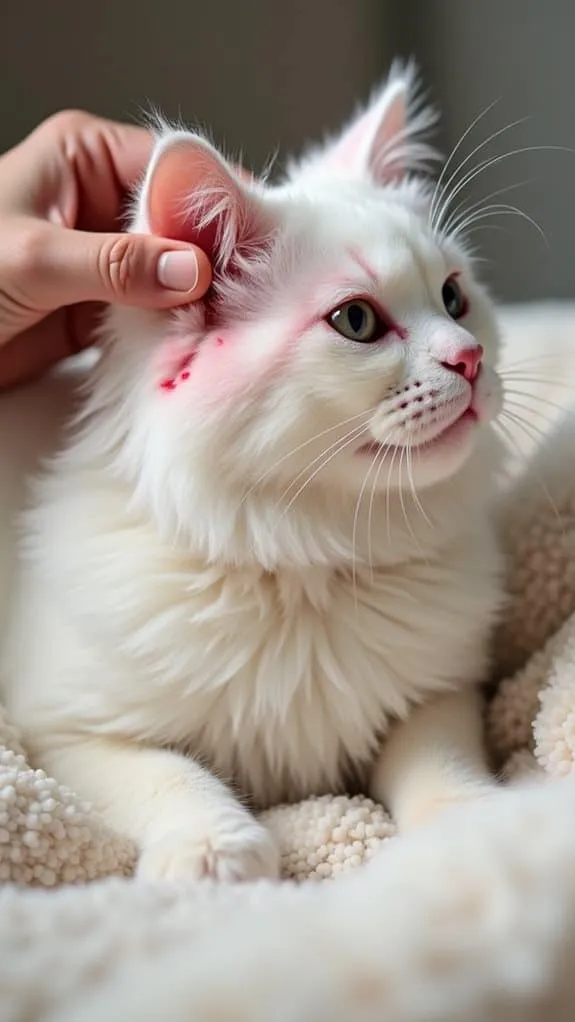
While many skin issues can be managed at home, recognizing when your cat needs professional veterinary care is crucial for their health and comfort.
If you've noticed persistent skin problems, open sores, or if your kitty's behavior has changed notably, it's time to consult a feline dermatology expert. Cat skin allergies can be complex, and your furry friend might need specialized testing to identify the root cause.
Don't wait to seek help if home remedies aren't working or if your cat seems unusually lethargic.
Your vet can perform various tests, from skin scrapings to allergy screenings, to determine what's bothering your sensitive companion.
Protective Measures for Indoor-Outdoor Cats
After getting professional guidance for your cat's skin concerns, let's talk about keeping your indoor-outdoor kitty protected during the winter months.
Indoor outdoor safety starts with gradual temperature adjustments to help your furry friend shift comfortably between environments. You'll want to establish a consistent routine that includes thorough drying and monitoring for signs of distress.
Here are three essential steps to protect your cat:
- Use pet-friendly sweaters when temperatures drop below freezing
- Keep a warm, dry towel by the door to remove moisture immediately
- Set up heated mats near entry points for quick warming
Remember to practice temperature gradualism by creating a warm shifting zone near doorways. This helps your cat's skin and body adjust naturally while preventing the shock of sudden temperature changes.
Selecting the Right Products for Sensitive Skin
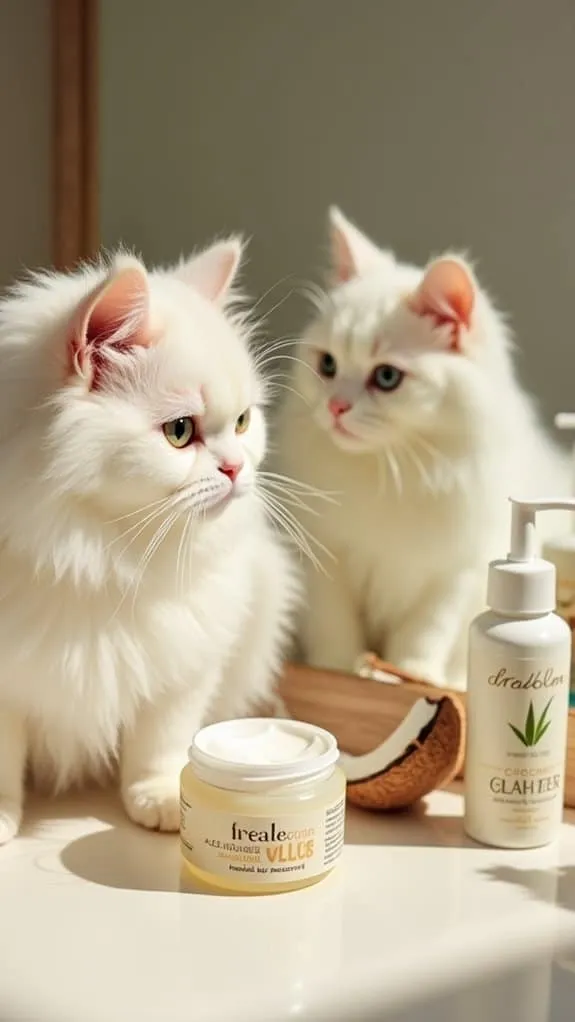
Since your cat's skin requires special attention during winter, choosing the right products becomes essential for maintaining their comfort and health.
When selecting sensitive ingredients for your kitty's care routine, look for moisturizing products containing natural elements like colloidal oatmeal, aloe, and olive oil. These gentle ingredients help protect and nourish your feline friend's delicate skin without causing irritation.
For effective moisturizing techniques, you'll want to avoid harsh cleansers and heavily fragranced products that can upset your cat's skin barrier. Instead, opt for products with hydrating components like glycerin and hyaluronic acid.
Don't forget to complement these choices with a humidifier in your home – your kitty's skin will thank you!
Monitoring and Adjusting Your Cat's Winter Care Routine
Keeping a watchful eye on your cat's well-being during winter months requires a thoughtful balance of monitoring and adjusting their care routine. When you notice changes in your cat's behavior, like increased napping or decreased activity, it's time to make thoughtful adjustments to their care plan.
To guarantee your sensitive kitty stays healthy and comfortable, follow these key monitoring steps:
- Track your cat's water intake daily, considering adding a heated water bowl if they're drinking less.
- Document winter activities and play sessions, adjusting the intensity based on their energy levels.
- Monitor their skin condition weekly, looking for signs of dryness or irritation.
Final Thoughts
Your sensitive kitty's winter wellness journey doesn't have to be complicated. With the right combination of humidity control, proper nutrition, and gentle grooming, you'll transform your home into a cozy cat spa that would make even the most pampered Persian jealous. Remember, you're not just maintaining your cat's skin health – you're creating an oasis of comfort that'll have your feline friend purring with endless gratitude through every snowflake and winter breeze.








